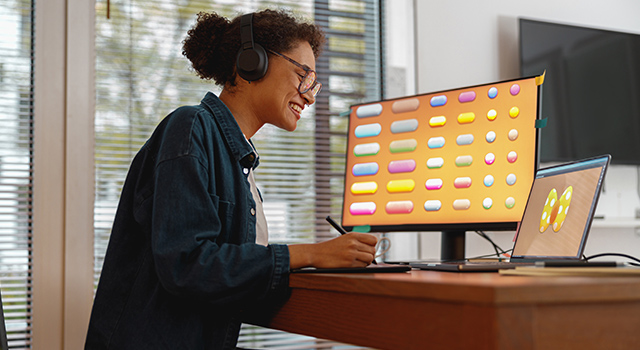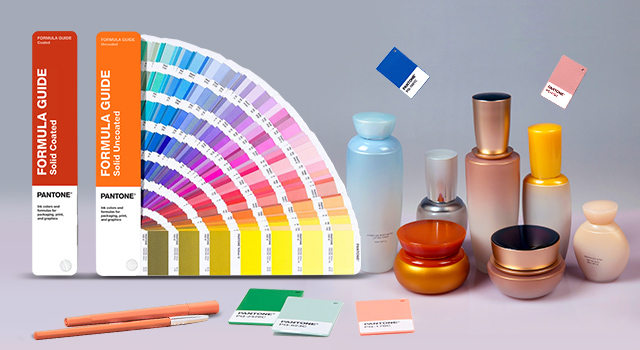Brand identity design connects you to your audience and is the most reliable and effective way to distinguish your organization from amongst your competition. It’s why you can see the famous “swoosh” symbol and immediately know that the brand being represented is Nike. But it’s not simply the visual representation of your brand through the use of color and design; it’s your brand’s story, values, people, products, and unique qualities that truly convey a strong association to brand identity. Beyond association, it’s an impression customer has with your brand, whether it’s quality, leadership, reliability, luxury, affordability, sass, or value.
Your brand identity design paves the way for distinctive brand marketing opportunities to support your brand strategy. Brand identity design plays a key role in distinctive marketing and should project a consistent message to target audiences.
Distinctive Marketing and How It Relates to Brand Identity Design
Distinctive marketing establishes brand trust through consistency and familiarity and helps companies develop long term relationships with customers. Leveraging visual collateral helps businesses shape customer perception.
Logos
Integral to distinctive marketing, logos set the tone for all other brand imagery. It can encapsulate an entire message within a single image and is a core pillar of successful marketing campaigns.
Colors
Color association is woven into the very psychological fabric of brand values. Distinctive marketing makes strategic use of brand colors to articulate a company values; green for sustainability, orange and yellow for playfulness, and so on.
Iconography
Represents important brand themes, concepts, and ideas are used to improve customer understanding of a brand’s story. Marketing expert Neil Patel asserts that iconography in marketing increases brand engagement.
Infographics
Cuts through the marketing clutter and helps brand campaigns go viral. Infographics are shared on social media three times more often than any other marketing content, and convey brand content in easily digestible ways.
Brand Identity Designs that Tell a Story
Brand designs can depict entire stories about a company’s connection with its target audience. Companies use designs to speak their audience’s language, and when done effectively, can demonstrate the harmony between brand and customer.
- Edgy, Retro Designs Represent Gen Z: The famous 1990’s Southern California skater culture brand, Vans, features a retro-classic, edgy brand identity design that resonates with nostalgia loving youths. Their iconic checkerboard pattern, simple color palette, and skater symbols are popular with teen consumers and represent that demographic’s vintage-loving preferences and scorn of throwaway trends. As Vans seeks to eschew trends and be a constant source of cool, it remains a hallmark for younger generations.

- Do-it-Yourself reliability Resonates with Boomers: Home Depot, the do-it-yourself home improvement brand, utilizes a bold orange and white color theme, and a no-nonsense logo inspired by transport freight cargo that baby-boomer audiences associate with trust, practicality, and self-sufficiency. This generation’s strong work ethic, appreciation of value, and tendency towards self-reliance is advocated within the brand’s color, stark choices, and iconography and aligns with the brand’s marketing objectives.

- Wholesome, Quality Values for Busy Parents: Nestle’s baby food brand, Gerber, has featured the same baby in their brand identity design since 1928, which is a recognized trademark all over the world since 1931, appearing in all packaging and products ever since. An updated charcoal sketch, colors, and conversational themes appeal to busy, modern parents of diverse backgrounds who care about quality, wholesome baby food ingredients while remaining true to its roots as a comforting and familiar household brand.

- Earthy Imagery Epitomizes Eco-Conscious Consumers: Seventh Generation’s eco-friendly consumer products brand utilizes green, earthy colors, nature symbols, and simple typography to convey corporate responsibility, environmental consciousness, and social advocacy. Their brand identity designs tell the story of their customers – healthy conscious communities and individuals who desire ethical choices, transparency in ingredients, and a nurturing of the environment for the next generation.

- Stark, Sleek Typography and Symbols are a Staple of Millennials: Amazon is the favorite brand of millennials, and their design identity, with its black, gray, and orange color formula, lowercase typography, and stark smiling arrow symbol, is emblematic of the quick-paced consumer goods brand for a generation that grew up on the cusp of the computer and internet revolution. The retail giant tells the story of its technology roots, streaming services, and direct delivery business model, a branding objective that also represents the delivery and subscription service trends favored by millennials.

Brand Identity Examples

Nike’s visual identity has always been strongly linked to athletic performance, healthy competition, and fitness, and tells the story of their brand, star athletes, and customers. Michael Jordan, Colin Kaepernick, and Christiano Ronaldo are just a few sports pros whose stories are woven into the fabric of the brand itself so that Nike’s designs have also become an inextricable part of the lore of sports history:
- Heroic connotation of the “swoosh,” a symbol of sports culture, which represents motion, speed, and sound, and the Greek goddess of Victory, Nike.
- “Just Do It” slogan is always featured in bold, elegant font with geometric shapes.
- Design association with sports celebration, self-empowerment, global responsibility.
- Red, white, and black is a longtime preferred brand color palette to represent passion, nobility, and purity.

High-end fashion brand Chanel uses its brand design to indicate the brand’s longtime values to their target customers: timeless luxury, artistic legacy, durability, understated sophistication, and statement-making design. Brand founder, Gabriel Coco Chanel remains the brand’s inspiration, and brand designs adhere to her “less is more” interpretation of classic elegance:
- Overlapping, double “C” logo was designed in 1925 and remained a consistent brand feature that attracts customers who want enduring designs.
- Famous quilted and tweed patterns, which are reinterpreted every season, along with a black and white color palette, is a brand staple.
- Attention to simple detail represents the brand’s emphasis on a woman’s liberation from trends.

The Seattle based coffee brand is not only notorious for being on every corner, but for its iconic, easily recognizable siren logo, and green color palette, expressive traits that are incorporated into their creative, confident brand identity designs:
- Harmonious typefaces add purpose to customer interaction with the brand.
- Optimistic symbols reflect seasonal changes and globally celebrated holidays.
- The nautical theme captures the brand’s story, rooted in Seattle’s Pike Place Market.
- Simple black and white mermaid, or siren, symbol is encased in variations of green, color the brand associates with peace and growth.
- The recent elimination of any wordmark within their logo represents a clean, more prominent visual brand symbol.

Apple’s stylized logo, with its bite mark, grayscale colors, and modern minimalism, symbolizes the brand’s technological innovation and is one of the most familiar designs in modern culture. Wired describes their trademark font as the “world’s favorite typeface.” The current apple logo, with its playful, techno quality, has been a constant for over 40 years, and is linked to overall design identity:
- Sleek design associates the brand with technology, exclusivity, and creativity, and creates an impression that its products embody similar attributes.
- Monochromatic color palettes and frosted, chromatic steel designs persist today.
- The introduction of the “space gray” color in 2013 unifies all product designs.
- A new bespoke font for all typography, called “San Francisco,” has been coveted since 2015.

The luxury automotive company features the most recognizable brand design in America. It attracts target customers with a promise of exclusivity, modern engineering, lavish comfort, and status. Their brand identity design is focused on a “gene pool” of style elements to create a living tradition:
- Brand pedigree with functional, shapely lines that mirror company philosophy.
- Reuse of their radiator grille, a design feature used for over 100 years, whose basic proportions haven’t been changed despite the introduction of dynamic new style features.
- The three-pointed star represents land, sea, and air, the three “arms” of the business.
- The use of simple, minimal, geometric designs conveys dependability, stability, and quality.
Things to Consider while Designing for Distinctive Marketing
Distinctive marketing emphasizes repetition and unification and must be reinforced throughout all design branches. Boil down qualities that embody your brand’s identity, message, target audience, and story, and use this as the foundation from which to build designs.
Do-Infuse Brand Personality: Infuse human characteristics of brand identity into the design to ensure audiences can relate. Consider the functional benefits of your products or services and add unique personality traits to elevate emotional responses.

Do-Purpose and Clarity: Use a purposeful design that communicates brand messages in both design concepts and execution for strategic brand positioning that stands out from competitors.

DoBe Consistent: Color, fonts, typography, and symbols should be integrated across all marketing materials. Subtle variations add freshness but should incorporate recognizable design elements to continue to nurture customer familiarity.

Design for Your Audience: Always remember to design for your unique customer base to increase customer loyalty and prevent potential disconnects between your audience and your brand.

Distill Brand Identity into Powerful Designs
According to Harvard Business Review, 64% of people that say they have a relationship with a given brand state shared values as the main driver of the relationship. Build customer relationships and convey your company’s values with professional brand identity designs.
As a top creative house, Artwork Adobe (AWA) is not only a brand identity design provider, and we’re a brand strategist. We collaborate with clients to distill their brand voice, message, value, and story into powerful designs. Whether it’s logos, typography, iconography, symbols, icons, or colors, AWA is here as a strategic asset in developing your brand identity designs.
– Artwork Abode
Disclaimer:All the product names, logos, trademarks, and brand names are the property of their respective owners. All the products, services, and organization names mentioned in this page are for identification purpose only and do not imply endorsement.



